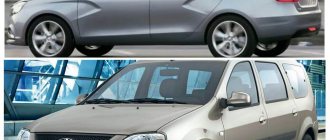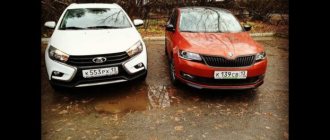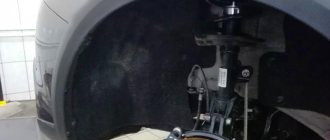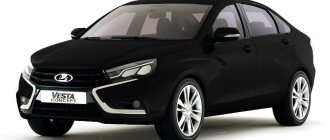Recently, AVTOVAZ presented two versions of the Lada Vesta station wagon. Although these two cars are very similar, they have a number of distinctive features. We decided to put the Lada Vesta SW (a simple station wagon) against the “cross”, compare these two modifications and find the main differences.
Differences in technical characteristics
| Parameter | Lada Vesta SW | Lada Vesta SW Cross |
| Dimensions (length x width x height) | 4410 x 1764 x 1512 | 4424 x 1785 x 1532 |
| Curb weight | 1280..1350 kg | 1280..1350 kg |
| Ground clearance | 178 mm | 203 mm |
| Tires | 185/65 R15 and 195/55 R16 | 205/50 R17 |
The larger body dimensions of the cross-version are due to the presence of the original body kit.
Differences in suspension:
- Lada Vesta SW - the rear springs of the station wagon (compared to the sedan) were increased by 9 mm.
- Lada Vesta SW Cross - different shock absorbers and springs, different suspension settings. The track is 14 mm wider.
Interior ergonomics
The spacious and stylish interior immediately catches your eye. A successful color combination, together with the high quality of finishing and materials used, gives the interior of the Lada Vesta SV Cross 2017 solidity. Being in it in no way gives the feeling that you are sitting in a domestic car. The torpedo has a relief, laconic, everything is in its place.
So what I see:
- the instrument panel stands out - the bright color of the scales looks stylish;
- The steering wheel is quite pleasant, but not leather, although for that kind of money it could be made so. It is reach adjustable;
- the touch display is quite good in size;
- impressive size glove box;
- armrest where you can put various small things.
Reading some reviews about the 2022 Lada Vesta SV Cross, you can see ambiguous mention of the car’s driving performance. But now let's check everything, let's go.
What is the difference between station wagons and trim levels?
Additional options that only Lada Vesta SW Cross has:
- Original off-road body kit.
- Body color "Mars" (orange, 130).
- Interior color (orange trim).
- Decorative exhaust pipe nozzle.
Suspension
The chassis of the Lada Vesta is an advantage of this car. The rear is completely taken from the Renault Megane, but the engineers did a very good job with the front, creating it from scratch using L-shaped arms, mounting on a subframe and MacPherson struts. Some components, of course, were taken from Alliance cars, but in general it was the front suspension that turned out to be a unique and successful development by our engineers.
Precise tuning and successful suspension design made Vesta a comfortable and obedient car. Even in the very first tests, experts noted the car’s obedience, its directional stability in corners and other advantages.
"Vesta", being presented for the first time at the international motor show in Moscow in August 2014, created a real sensation. Since then, potential customers, fueled by news about the upcoming mass production of the concept, have been counting the days until the first arrival of the “new product” in car dealerships.
Serial production of Vesta started on September 25, 2015 at the VAZ plant in Izhevsk. It is expected that over time the assembly of these cars will be carried out in Togliatti and Ust-Kamenogorsk.
Price difference
Station wagon cost:
- Lada Vesta SW from 639,900 to 804,900 rubles.
- Lada Vesta SW Cross from 755,900 to 847,900 rubles.
Having an amount of about 760 thousand rubles, the buyer begins to think about which of the two station wagons is better to buy:
- Lada Vesta SW 1.8L with manual transmission in the Luxe Multimedia package for 761,900 rubles.
- Lada Vesta SW Cross 1.6l with manual transmission in Luxe configuration for 755,900 rubles.
A regular station wagon will have:
- More powerful engine.
- Multimedia system with navigation 7".
- Rear view camera.
A regular station wagon will not have:
- Original body kit.
- Body color "Mars".
- Orange interior trim.
- Exhaust pipe nozzle.
- Increased ground clearance.
- A different suspension (different from the sedan).
- Alloy wheels R17 (will be R16).
LADA VESTA ENGINES
| Volume | power hp at rpm | Torque N*m at rpm | consumption l/100 km highway/city | acceleration sec. 0-100 km/h | Max. speed km/h |
| 1.6i | 106 / 5800 | 148 / 4200 | 5.3 / 8.9 (5AMT) 5.5 /9.3 (5MT) | 12.8 (5AMT) 11.8 (5MT) | 178 |
| 1.8i (AMT) | 122 / 5900 | 170 / 3700 | 6/9.3 (AMT) | 12.1 | 186 |
Station wagon models with off-road capabilities are gaining more and more popularity. And the concept of a similar LADA Vesta Cross station wagon has long been tantalizing the appetites of Russian, and not only, car enthusiasts. Back in August 2015, the conceptual cross-station wagon was presented to the public in all its glory, but there was still no production model. And finally, patent images of the upcoming car have appeared.
INTERIOR AND EXTERIOR LADA VESTA CROSS
The concept station wagon Lada Vesta Cross, designed by British designer Steve Mattin, turned out to be very nice. The exterior of the station wagon uses the X-style; the dark segment of the front end of the station wagon is not limited to the lower air intake: the central lower part of the bumper and the protective lining around the perimeter of the car are now painted in a dark color. A special feature of this station wagon is the sloping roof, which smoothly flows into an integrated spoiler, and the rear door, which covers a significant segment of the roof with the same spoiler. A stylish decorative feature is the blackout under the rear roof (the C-pillar segment is painted dark), which creates the illusion of a floating roof. Stylish silver roof rails give the car a sporty look.
Inside, the station wagon is no less sporty: deep sports seats with an X-shaped pattern, a three-spoke multifunction steering wheel and contrasting details (orange) as an accent. But most likely, the interior of the serial Lada Vesta Cross station wagon will be different, although the Russian automaker says that it will try to bring the bright interior to mass production; it, along with other changes, will distinguish the Vesta cross station wagon from the regular version.
Ground clearance promises to be as much as 300 mm. The concept is shod with 18-inch wheels (the production version expects wheels no larger than 16 inches). There are no exact figures for dimensions yet, but the length of the station wagon does not exceed that of a sedan, and therefore you should not expect large capacity and volume of the luggage compartment.
EQUIPMENT OF LADA WESTA CROSS
According to the latest information, the off-road station wagon will not receive the promised all-wheel drive system, but only an “electronic imitation of a differential lock.” There is no information about the engines yet, but probably these will be the same power units as the regular Vesta, namely: VAZ 1.6-liter with 106 hp, Nissan 1.6-liter (110 hp). s.) or the new VAZ 1.8-liter (222 hp). Transmission options, such as a 5-speed manual and robotic gearbox, may also be borrowed from the regular Vesta.
The LADA Vesta Cross station wagon is promised to be released in 2022. It is planned to produce up to 20,000 station wagons per year. Most of the stamped parts will be produced at the AVTOVAZ plant in Izhevsk. And first we will see a non-cross version of the station wagon.
Design Features
In terms of its parameters, the Lada Vesta stands out noticeably among the general flow of cars in the domestic automobile industry. Its platform belongs to the European class B+ or B/C, however, Vesta’s ground clearance and wheelbase are slightly greater than those of foreign representatives of this segment.
The development of the platform was carried out jointly with Renault-Nissan engineers as part of the Siluet conceptual project and lasted five years. As a result of joint work, the new Lada received a more rigid body than previous VAZs, a new suspension, as well as an imported steering unit with a traditional electric power steering.
The car is equipped with a choice of three power units of different power, and three gearboxes, one of which is a domestically produced “robot”.
The exterior and interior of the car have also undergone fundamental changes. The non-standard design for VAZ and the modern interior, along with the “filling”, made Vesta a full-fledged competitor to foreign representatives of the B+ class.
Transmission
Lada Vesta is equipped with three types of transmission. Most models are equipped with a five-speed manual gearbox, which was equipped with previous Lada models. The gearbox was modified, as a result of which some of its elements were replaced with imported ones (Japanese and German). The gearbox became noticeably quieter, gears began to shift easier.
Another transmission option was not the classic “automatic”, but the robotic AMT 2182, designed on the basis of the existing 2180 mechanics. Despite the shortcomings that manifest themselves in the form of jolts and jerks when changing gears, the AMT has a real chance of becoming a full-fledged alternative to the “automatic”.
The third type of transmission is a variator from the Renault-Nissan alliance, successfully tested on the Nissan Tiida.
Gear ratios for each type of Lada Vesta transmission
| Broadcast | Manual transmission 2180 | AMT 2182 | CVT JH3 510 |
| Glavnya | 3,938 | 3,938 | 4,357 |
| 1st | 3, 636 | 3,636 | 3,727 |
| 2nd | 1,950 | 1,950 | 2,048 |
| 3rd | 1,357 | 1,357 | 1,393 |
| 4th | 0,941 | 0,941 | 1,029 |
| 5th | 0,784 | 0,784 | 0,795 |
| Rear | 3,500 | 3,500 | 3,545 |
Weight of Lada Vesta engines and transmissions
| Power unit | Transmission | |||||
| VAZ-11189 | VAZ-21129 | HR16/H4M | Manual transmission 2180 | AMT 2182 | CVT JH3 510 | |
| Weight, kg | 92,5 | 109,2 | 93,4 | 32,0 | 32,8 | 35,0 |
Exterior and body
- the result of the work of Steve Mattin, proposed by him for another VAZ concept X-RAY. “X’s” are present both in the design of the front end and in the outline of the sidewalls. The aggressive appearance is complemented by slanting headlights that “climb” onto the hood, as well as alloy wheels. The stern looks no less impressive. Huge trapezoidal lights, a high bumper with lower trims and a strongly inclined rear window give the car confidence and solidity.
The body of the new Lada is traditionally made of steel. There are no aluminum or composite materials here. This decision was made by the developers in order to strengthen the body. According to their assurances, it turned out to be several times tougher than that of the Priora. This not only increased the level of safety, but also prevented doors from sagging, eliminated various plastic squeaks caused by the “play” of body elements, and, in addition, made car control more “sharp.”
Interior
The interior of the new VAZ is significantly different from previous versions. The interior design combines minimalism, sporty style and high-tech. A completely new instrument panel catches your eye.
The dashboard is characterized by sharp bends, repeating the letter “X”. The devices themselves are immersed in three deep “wells,” which again makes the interior more sporty.
The driver and front passenger seats have also been updated.
They now have a wide range of settings, incl. and in height. There is plenty of space in the back, it’s not for nothing that the length of the car has been increased.











